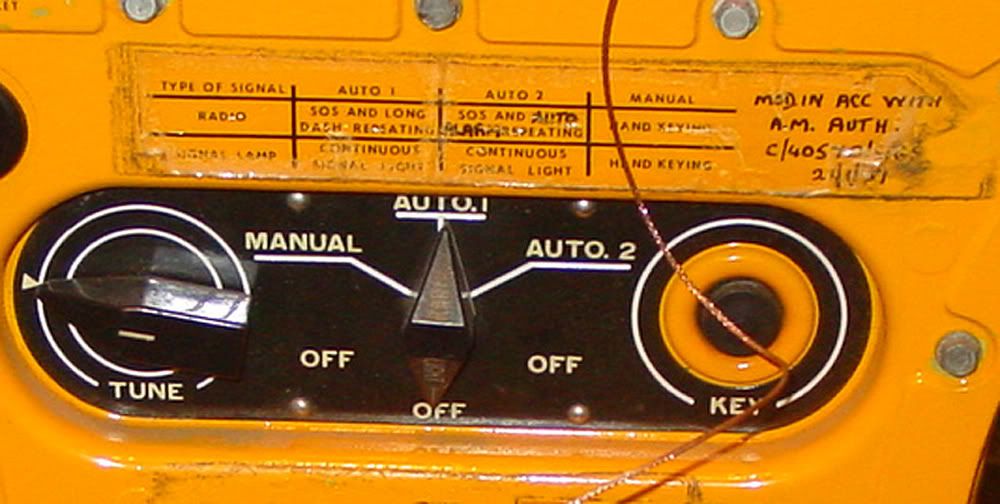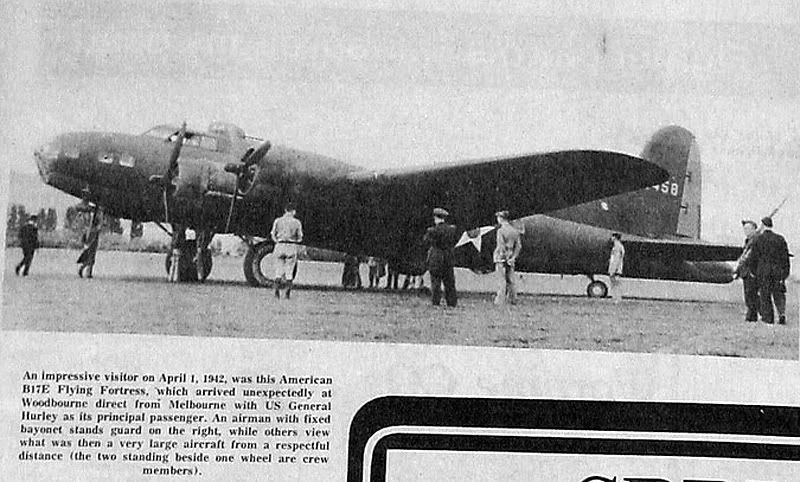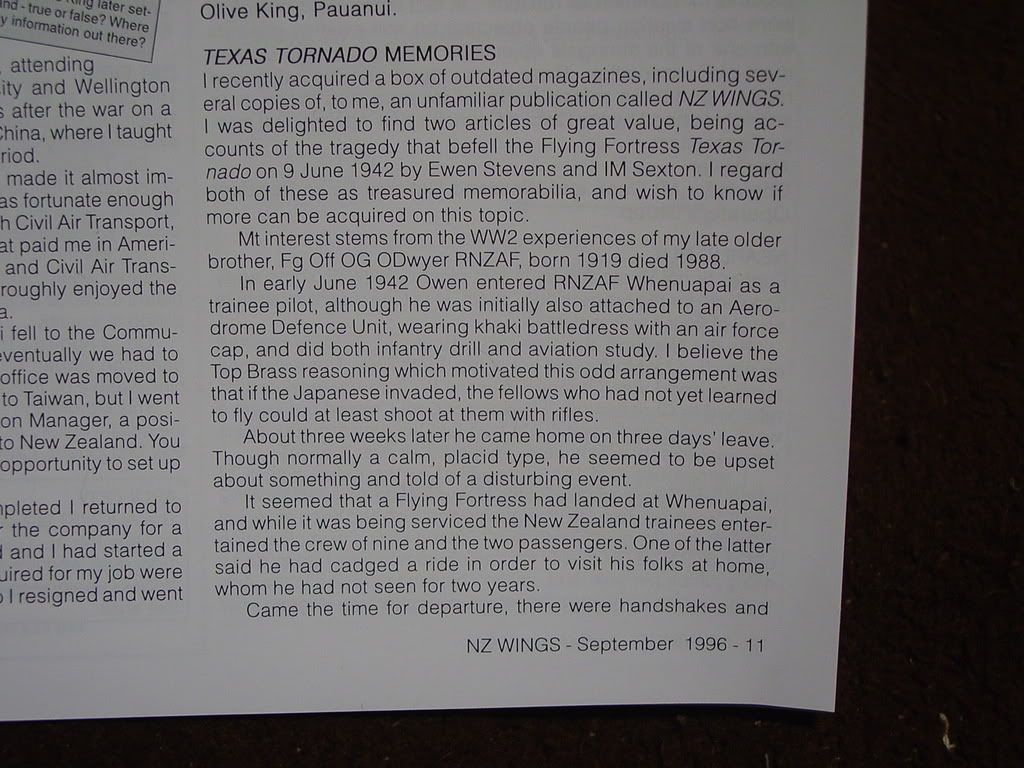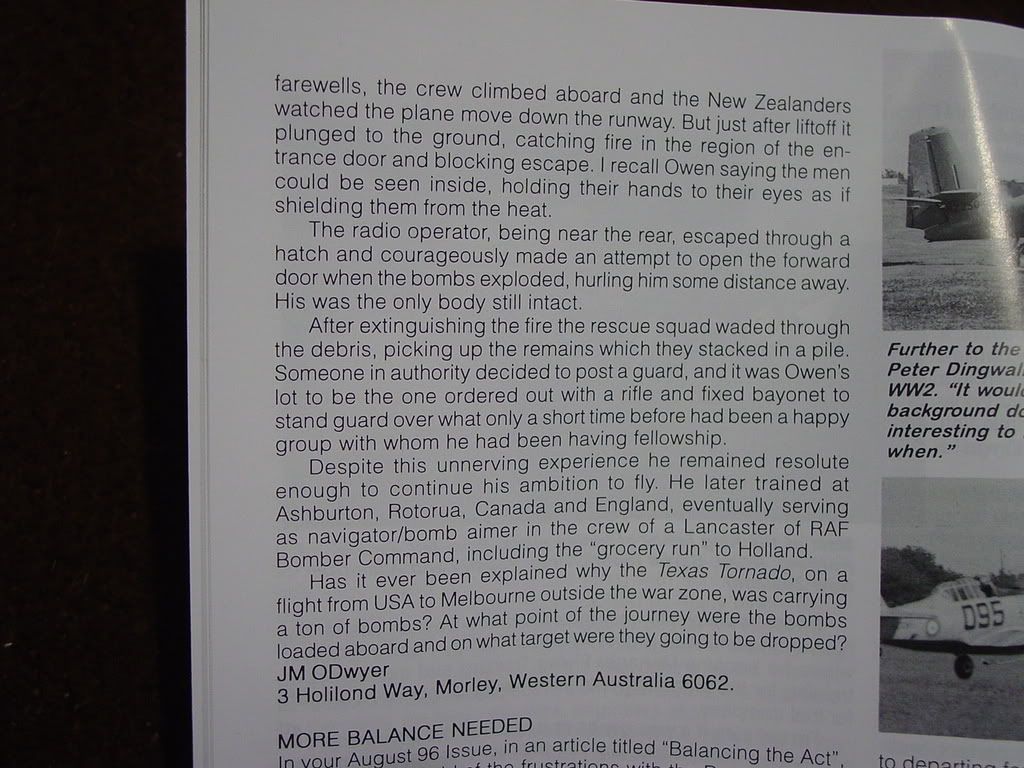|
|
Post by angelsonefive on Jul 21, 2008 14:06:55 GMT 12
Most likely to be a US machine.
Only a small number of B-17s were converted to the maritime SAR role, all of them G models.
Seventeen off for the US Coastguard, designated PB1G, and 12 off for the USAAF, designated B-17H or SB17G. This was between 1945 and 1948, according to Wikipedia.
The absence of national insignia under the port wing militates against it being French or RAF.
The aerials could well be, in my opinion, intended to pick up signals from the hand-cranked portable emergency transmitter that was carried by larger USAAF aircraft in those now far off days, known to history by its nickname "Gibson Girl".
A great pic. Thanks for posting.
|
|
|
|
Post by Dave Homewood on Jul 21, 2008 14:20:33 GMT 12
We still had Gibson Girls in the Hercs, Orions and F-27's in my day, perhaps the two former types still do? They were wonderful contraptions and I always smiled when I saw one identical to the ones I worked on the WWII Pacific display case in the Wigram museum.
|
|
|
|
Post by angelsonefive on Jul 21, 2008 15:06:41 GMT 12
Dave,
Can you remember the frequency on which the Gibson girl transmitted ?
I suspect that it was the international shipping emergency freq. of 500 kcs, on which all ships at sea had to keep guard, but it would be useful to know for sure.
|
|
|
|
Post by Dave Homewood on Jul 21, 2008 16:55:19 GMT 12
I have no idea any more I'm afraid, sorry, I only serviced the ancillary equipment on them and not the radios themselves. But here is a photo I took of the Gibson Girl in the museum for your interest.  And a closer look at the dials if that helps  |
|
|
|
Post by alanw on Jul 21, 2008 17:59:01 GMT 12
Yesterday Hairy posted
I would say this is most likely a Post WWII USAF SB 17. (has no armament)
They are a modified B 17G with the radar scanner replacing
the chin turret
These started flying in the last few months of WWII
(Edit Sorry hadn't seen anglesonefive post till now)
Yesterday Dave wrote
Dave I checked the Buearu No's and the only B 17E I could find with 458 was 41-2458 (*Yankee Diddler*) damaged by air action and crash landed Pasiran (Indonesia) Feb 8, 1942. As luck would have it any other B 17E's with 58 in the serials were missing!!!
Of note I also found (probably 1942/43) a B17 F was transferred to New Zealand, fate uncertain Buer No 41-24430
|
|
|
|
Post by Dave Homewood on Jul 21, 2008 18:24:31 GMT 12
Interesting. 41-24430 is the one seen in the hangar (see page two of the thread). I just had another look at it and noticed a lighter patch on the ceiling of the concrete hangar. I'm wondering, is that No. 3 Hangar at Whenuapai that suffered the Hudson through its roof?
|
|
|
|
Post by hairy on Jul 21, 2008 22:05:48 GMT 12
And another............. ;D  (Whites photo) Enlarged below..........  This time we have a date, 4 August 1947 at Whenuapai. By the way I love the name of the Pan Am DC-4, "Clipper Racer".   |
|
|
|
Post by Bruce on Jul 21, 2008 22:22:36 GMT 12
I'm not sure the light patch matches up with the hole in the roof made by the Hudson - it would be on the other side (assuming the aircraft are placed facing towards the door) according to photos in John Kings book "NZ tagedies - Aviation". It could still be Whenuapai, but if it were the Hangar damaged by the Hudson it would have to be before that accident. I'm fairly certain 41-24430 was outside when the Hudson hit:  this is a photo from John Kings book, credited to RNZAF (Museum) in the foreground some of the remains of NZ2077, with a B17 in the background. Dated Dec 1942. It would be several months after this before the Hangar would be useable again. A rough and ready enlargement (despite drop in quality) shows it has the lower profile dorsal turret which makes it an E or an F model. Of interest however is the appearance of disruptive camouflage - the other pictures of '24430 show itr in standard olive drab over the top surfaces. the serial cannot be distinguished, which does create some uncertainties.  BTW doesnt May 1942 for the Texas Tornado visit seem quite early for a 1941 fiscal year B17? it would have to have been virtually brand new..... |
|
|
|
Post by sniff on Jul 21, 2008 22:27:19 GMT 12
Gibson Girl used by RNZAF post 1974 transmitted on 500 kc and 8364 kc
Carried on Devon, Dak and Freighter too.
|
|
|
|
Post by Dave Homewood on Jul 21, 2008 23:11:00 GMT 12
Bruce, how do you know that is 41-24430? Does the book say that? It's certainly in a different paint scheme, and the serial doesn't seem to be on the tail.
|
|
|
|
Post by Bruce on Jul 21, 2008 23:32:05 GMT 12
In all honesty it probably isnt - I was typing a fairly random train of thought whilst sorting out the photos!  Just mixing the Hudson line with Whenuapai hangars and B17s..... At least the date and location are pretty certain for this one - whatever it is! |
|
|
|
Post by alanw on Jul 21, 2008 23:35:17 GMT 12
Today Bruce wrote
It appears that disruptive camo was not uncommon on B 17E's
and some F's (though by the F version medium green blotching over OD was the norm).
I have some profiles of a B17E and F wearing such camouflage.
As a bit of Trivia thye USAAC for a time (up until 1941) had various a/c painted in washable camouflage for war games and dissimilar combat types scenarios
|
|
|
|
Post by Dave Homewood on Jul 21, 2008 23:59:22 GMT 12
Here's the one that visited Woodbourne  So, so far we have - B-17D 40-3097 'Swoose' visited NZ at some point and I think actually came and went and was here a fair bit, maybe even stationed in NZ for a while sometime between March and August 1942 as General George Brett's transport. It went to the USA in Aug 42 and stayed there. - a B-17 4?-???58 arrived at Woodbourne from Melbourne on the 1st of April 1942 as Brigadier General Patrick Hurley - B-17E 41-2667 "Texas Tornado" visited Whenuapai in June 1942 and crashed 9 June 1942 taking off on secret mission - a B-17E/F visited Whenuapai in December 1942 and was present on the 17th of December 1942 when a Hudson crashed through the roof of the hangar Plus at least two postwar visits as seen in Marcus's Whites photos. I know there's a shot of The Swoose in an old Wings magazine with more info but I've not relocated it yet. |
|
|
|
Post by angelsonefive on Jul 22, 2008 11:50:07 GMT 12
Thanks, Sniff for the info. about the Gibson Girl. and Dave for the pics.
Regarding post-war B-17 visits....
The 21st birthday airshow at Ohakea in '58 was attended by an impressive USAF contingent.
I recall seeing F-84 Thunderjets, F-100 Super Sabres, B-47 Stratojets and a B-17 VIP transport which brought the commander of the US contingent here from Hawaii, if I remember correctly.
I guess there must have one or more tanker aircraft as well to enable the fighters to get here.
Incidentally, in my Google search for information about the B-17, I saw that very recently the surviving D model, the Swoose was shifted from the Smithsonian storage facility at Silver Hill in Maryland, where the aircraft has been in a dismantled state for decades, to the USAF National Museum at Dayton for restoration and display.
|
|
|
|
Post by shorty on Jul 22, 2008 13:47:53 GMT 12
Turned up some more details from AHSNZ notes of visits as follows.
1 April 42 a B-17E 41-2458 (Lt Bridge, pilot and a crew of 8) arrived at Woodbourne from Australia with Gen Hurley as a passenger.
11 April departed for Wigram and one motor cut out en route, as a result of a serious oil leak, completely destroying the engine completely.
17 April returned from Wigram
18 April Took off at 0809 hrs for Melbourne, arriving there at 1609 Hrs (presumably NZST)
The visit to Wigram was almost certainly connected with the preparation of the dispersal field at Te Pirita as well as summer dispersal strips at Cust and Rotherham. All 3 fields were designed specifically to handle B-17s and it is known that a B-17 pilot visited Te Pirita at about this time.
19 May 1942 B-17D 40-3097 (The Swoose), pilot Capt Kurts with Air Marshall Sir Charles Burnett and party arrived at Woodbourne from Australia at 0800hrs and departs the following day fro Fiji.
21 may 42 the swoose arrived in Nadi from Woodbourne at 0800 and departs for Tontouta (New Caledonia) at 0825 hrs
30 May 42 Swoose flies from Nadi to Woodbourne.
3 June Swoose departed for Melbourne
The Swooset was the personal aircraft of Lt Gen George H Brett, Comander Allied Air Forces, South West Pacific based in Brisbane. He decided to use this veteran rather than deprive operational units of one of the newer and more effective E models.
|
|
|
|
Post by Dave Homewood on Jul 22, 2008 19:11:04 GMT 12
Thanks for that info Shorty. So was 41-2458 a combat-weary early E model? Yes, it was the news of Swoose moving that got me wondering about its, and the other B-17's time in NZ. Hopefully it will finally be reassembled, restored and put on display. I'd forgotten about the VIP B-17 at Okahea for the 21st, good call there Ray. I found this letter last night too in a Wings issue  And over the page:  |
|
|
|
Post by shorty on Jul 22, 2008 19:49:17 GMT 12
Dave, amended my post to make more sense.
|
|
|
|
Post by shorty on Jul 22, 2008 19:50:31 GMT 12
Dave, amended my post to make more sense.
|
|
|
|
Post by shorty on Jul 23, 2008 9:14:42 GMT 12
More on the current status of "The Swoose"
DAYTON, Ohio — The oldest surviving B-17 Flying Fortress is leaving the
Smithsonian Institution in Washington D.C. to be restored at the Air Force
museum in Dayton.
Sarah Parke, spokeswoman for the National Museum of the United States Air
Force, says the restoration process will take several years before going on
display in Dayton.
The fuselage and other parts already have been transferred.
The Air Force says the bomber, known as “The Swoose,” was originally called
Ole Betsy and flew in the first combat mission in the Philippines after the
attack on Pearl Harbor. After repairs in 1942, it was renamed The Swoose —
after a song about a bird that is half swan, half goose.
and some more
B-17D-BO 40-3097
The Washington Post reported on Saturday, 3 November 2007, that the Air and
Space Museum's collections committee, an advisory group on the acquisition
and transfer of aircraft, vote 5-4 on 28 September 2007 for deaccessioning
The Swoose, and transfer the aircraft to the National Museum of the United
States Air Force in Dayton, Ohio.
The panel forwarded its decision to Gen. John R. "Jack" Dailey, the museum
director, and Donald S. Lopez Sr., the deputy director, who subsequently
decided to stand by the committee's recommendation. "There were good
arguments on both sides," said Dailey, who had requested a collections
review to alleviate a storage crunch at the Silver Hill, Maryland facility
where ''The Swoose'' has been stored since 1961. The Swoose has never been
in a plan to be displayed, Dailey said. The decision now must be approved by
the Smithsonian's National Collections Program office. The Air Force Museum
is not commenting on the exchange until the internal process at the
Smithsonian has been completed.
|
|
|
|
Post by Dave Homewood on Jul 23, 2008 11:15:55 GMT 12
|
|

